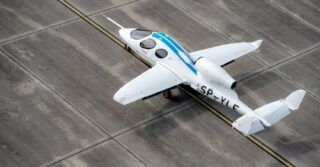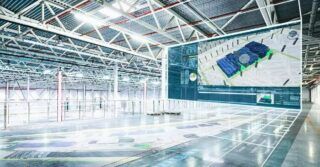The technology of digital twin is much more than what many companies have believed so far, as a way of creating 3D models of products and solutions. We now know that its full utilization allows for significant cost reduction, shorter time to market, increased sales, and improved operational efficiency. Importantly, digital twins can also support sustainable development. This is especially crucial for the aerospace industry, which leads in terms of carbon dioxide emissions. As many as 73% of companies in this sector have ambitious plans related to the development of this technology.
Capgemini’s report, “Mirroring reality: Digital twins in aerospace and defense,” shows the growing interest in technology within organizations in the aerospace and defense (A&D) sector. Companies are reaching for it during their digital transformation and the implementation of intelligent operational processes. Currently, 73% of A&D organizations have a long-term strategy for using digital twins, compared to just 57% a year ago. Furthermore, almost two-thirds (61%) now consider this technology a strategic part of the company’s digital transformation, compared to 51% in 2021.
According to Capgemini’s study, the key drivers for investing in digital twins include a desire for technological development (78%), cost reduction (71%), shortening the time to market (70%), increasing sales (63%), and providing employees with a modern training environment (68%).
A digital twin is a precise virtual replica of a physical system or process that allows monitoring, analysis, and optimization of the physical original. This technology can be used, among other things, to test new products before their full implementation, train employees in a virtual environment identical to the real one, try out new business models, or create simulations in a risk-free environment – says Maria Nalapko, Global Process Owner of Digital Twin at Capgemini Polska.
Digital Twin is a key to decarbonization
The aviation industry has been one of the largest producers of carbon dioxide for years. In 2018, it emitted over a billion tons of CO2. Digital twin technology can play a crucial role in reducing the sector’s environmental impact. According to Capgemini’s data, two out of three (67%) organizations mention sustainable development as the main driver of investments in this technology. Just a year ago, only 60% of respondents provided such an answer.
Following the example of the automotive industry, airlines are looking for new ways to decarbonize, such as hydrogen fuel or electric batteries. However, to implement them, engineers must assess many scenarios as early as possible. In the conducted study, 75% of A&D organizations mentioned that digital twin technology can provide instant value from the very beginning of the product development and operations process. It allows engineers to virtually validate every step of the design process, reducing the time and costs associated with prototyping and testing. Moreover, this technology can improve the efficiency of existing engines and increase their utilization, which will save a significant amount of emitted carbon dioxide.
Proper data management is essential for digital twin success
Close to half (47%) of the organizations surveyed believe that implementing digital twin technology in the design phase will bring tangible benefits quickly. 39% believe it will also help optimize supply chains. 33% of respondents believe it will soon be able to support production engineering.
Supply chain issues also negatively affect the A&D industry. Creating a virtual networked environment for modeling, simulating, monitoring, analyzing the performance and flow of products in supply chains will help address disruptions and continuously optimize operations. Additionally, four out of five (81%) respondents believe that digital twin technology improves the availability and reliability of systems and equipment. 73% say it also optimizes production speed.
However, to achieve all these benefits, proper preparation for the implementation of digital twins is necessary. To fully harness their potential, an intelligent digital infrastructure and good data management are needed. This is confirmed by 78% of Original Equipment Manufacturers (OEMs) and Tier 1 suppliers who are pursuing initiatives related to this technology. The challenge arises here: almost 60% of organizations still point to a lack of integrated data platforms as a barrier to the adoption of digital twin technology.
The latest technological solutions, especially those that bring a number of tangible benefits, tempt companies and encourage them to implement them quickly. However, it is crucial to approach the topic wisely. The company’s technological development process must proceed gradually, and we must not forget about the fundamentals. In the case of digital twins, data management is undoubtedly crucial. As a partner in many digital twin implementation processes, Capgemini focuses on avoiding technological gaps and preparing data for integration – adds Maria Nalapko, Global Process Owner of Digital Twin at Capgemini Polska.


![Will digital twin revolutionize the aerospace and defense sector? [REPORT] Will digital twin revolutionize the aerospace and defense sector? [REPORT]](https://industryinsider.eu/wp-content/uploads/xdigital-twin-in-aerospace-980x512.jpg.pagespeed.ic.r47sVOKafm.jpg)

![Forecasts, Opportunities, and Challenges for the Polish Industry in 2024 [ANALYSIS] Forecasts, Opportunities, and Challenges for the Polish Industry in 2024 [ANALYSIS]](https://industryinsider.eu/wp-content/uploads/xIndustry-40-320x167.jpg.pagespeed.ic.o8zijDQlIJ.jpg)
![The importance of artificial intelligence in transport and automotive industry is growing [REPORT] The importance of artificial intelligence in transport and automotive industry is growing [REPORT]](https://industryinsider.eu/wp-content/uploads/xcity-320x167.jpeg.pagespeed.ic.xFkQdk7qXO.jpg)
![By 2030, the market size of metal processing tools is expected to reach $120.44 billion [REPORT] By 2030, the market size of metal processing tools is expected to reach $120.44 billion [REPORT]](https://industryinsider.eu/wp-content/uploads/xcutting-tools-320x167.jpg.pagespeed.ic.SgnEk-RWA-.jpg)
![Methane emissions remains elusive challenge for oil and gas industry [REPORT] Methane emissions remains elusive challenge for oil and gas industry [REPORT]](https://industryinsider.eu/wp-content/uploads/xMethane-emissions-by-source-320x167.jpg.pagespeed.ic.q-7jG2luXb.jpg)
